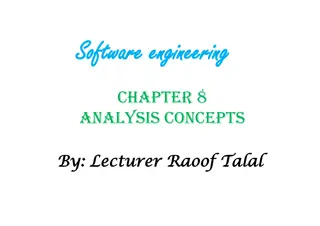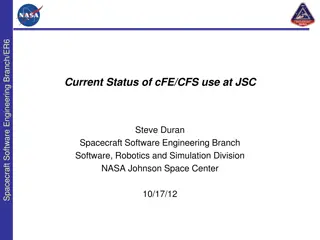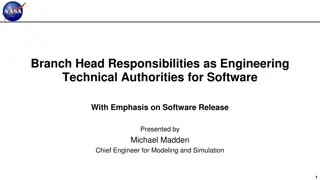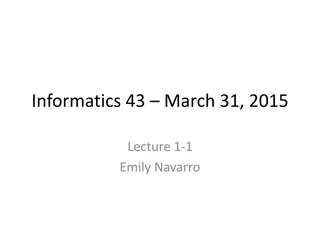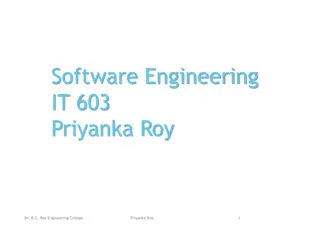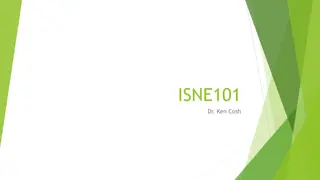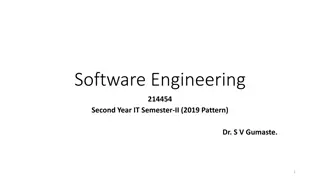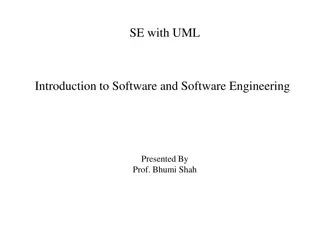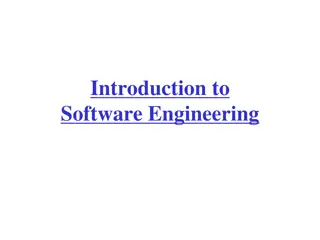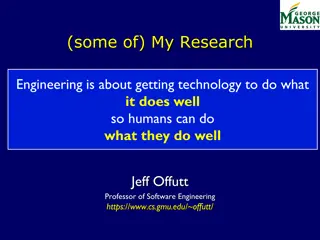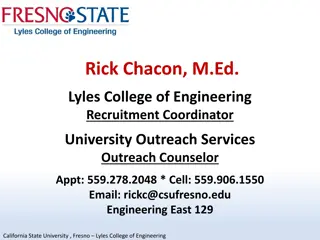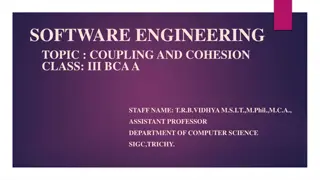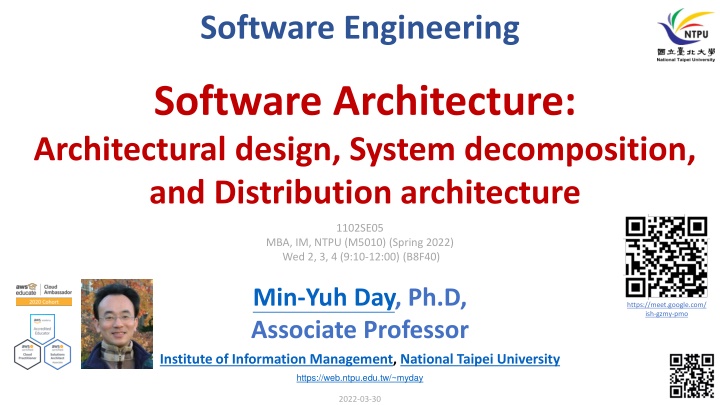
Software Architecture: Design, System Decomposition, and Distribution
Explore the world of software architecture, from architectural design to system decomposition and distribution. Dive into topics such as cloud-based software, microservices architecture, and industry practices in software engineering. Gain insights into agile methods, Scrum, and extreme programming for effective project management. Get ready to analyze, design, test, and maintain software systems in this comprehensive course.
Uploaded on | 0 Views
Download Presentation

Please find below an Image/Link to download the presentation.
The content on the website is provided AS IS for your information and personal use only. It may not be sold, licensed, or shared on other websites without obtaining consent from the author. If you encounter any issues during the download, it is possible that the publisher has removed the file from their server.
You are allowed to download the files provided on this website for personal or commercial use, subject to the condition that they are used lawfully. All files are the property of their respective owners.
The content on the website is provided AS IS for your information and personal use only. It may not be sold, licensed, or shared on other websites without obtaining consent from the author.
E N D
Presentation Transcript
Software Engineering Software Architecture: Architectural design, System decomposition, and Distribution architecture 1102SE05 MBA, IM, NTPU (M5010) (Spring 2022) Wed 2, 3, 4 (9:10-12:00) (B8F40) Min-Yuh Day, Ph.D, Associate Professor https://meet.google.com/ ish-gzmy-pmo Institute of Information Management, National Taipei University https://web.ntpu.edu.tw/~myday 1 2022-03-30
Syllabus Week Date Subject/Topics 1 2022/02/23 Introduction to Software Engineering 2 2022/03/02 Software Products and Project Management: Software product management and prototyping 3 2022/03/09 Agile Software Engineering: Agile methods, Scrum, and Extreme Programming 4 2022/03/16 Features, Scenarios, and Stories 5 2022/03/23 Case Study on Software Engineering I 6 2022/03/30 Software Architecture: Architectural design, System decomposition, and Distribution architecture 2
Syllabus Week Date Subject/Topics 7 2022/04/06 Make-up holiday (No Classes) 8 2022/04/13 Midterm Project Report 9 2022/04/20 Cloud-Based Software: Virtualization and containers, Everything as a service, Software as a service 10 2022/04/27 Cloud Computing and Cloud Software Architecture 11 2022/05/04 Microservices Architecture, RESTful services, Service deployment 12 2022/05/11 Industry Practices of Software Engineering 3
Syllabus Week Date Subject/Topics 13 2022/05/18 Case Study on Software Engineering II 14 2022/05/25 Security and Privacy; Reliable Programming; Testing: Test-driven development, and Code reviews; DevOps and Code Management: DevOps automation 15 2022/06/01 Final Project Report I 16 2022/06/08 Final Project Report II 17 2022/06/15 Self-learning 18 2022/06/22 Self-learning 4
Software Architecture: Architectural design, System decomposition, and Distribution architecture 5
Software Engineering and Project Management Design Test Deliver Build Analyze System and Software design Integration and system testing Operation and maintenance Implementation and unit testing Requirements definition Project Management 6
Information Management (MIS) Information Systems Organizations Technology Information Systems Management 7 Source: Kenneth C. Laudon & Jane P. Laudon (2014), Management Information Systems: Managing the Digital Firm, Thirteenth Edition, Pearson.
Fundamental MIS Concepts Business Challenges Management Information System Business Solutions Organization Technology 8 Source: Kenneth C. Laudon & Jane P. Laudon (2014), Management Information Systems: Managing the Digital Firm, Thirteenth Edition, Pearson.
Project-based software engineering CUSTOMER Problem generates helps-with implemented-by 1 Software Requirements CUSTOMER and DEVELOPER Source: Ian Sommerville (2019), Engineering Software Products: An Introduction to Modern Software Engineering, Pearson. DEVELOPER 9
Product software engineering DEVELOPER 1 Opportunity inspires realizes implemented-by Product features Software DEVELOPER DEVELOPER 10 Source: Ian Sommerville (2019), Engineering Software Products: An Introduction to Modern Software Engineering, Pearson.
Software execution models Stand-alone execution Hybrid execution Software as a service User s computer User s computer User s computer User interface Product functionality User data User interface Partial functionality User data User interface (browser or app) Additional functionality User data backups Product updates Product functionality User data Product updates Vendor s servers Vendor s servers Vendor s servers Source: Ian Sommerville (2019), Engineering Software Products: An Introduction to Modern Software Engineering, Pearson.
Product management concerns Business needs Product manager Technology constraints Customer experience 12 Source: Ian Sommerville (2019), Engineering Software Products: An Introduction to Modern Software Engineering, Pearson.
Technical interactions of product managers Product vision management Product backlog management User stories and scenarios Product manager Acceptance testing Customer testing User interface design 13 Source: Ian Sommerville (2019), Engineering Software Products: An Introduction to Modern Software Engineering, Pearson.
Software Development Life Cycle (SDLC) The waterfall model Requirements definition System and Software design Implementation and unit testing Integration and system testing Operation and maintenance 14 Source: Ian Sommerville (2015), Software Engineering, 10th Edition, Pearson.
Plan-based and Agile development Plan-based development Requirements engineering Requirements specification Design and implementation Requirements change requests Agile development Requirements engineering Design and implementation 15 Source: Ian Sommerville (2015), Software Engineering, 10th Edition, Pearson.
The Continuum of Life Cycles High Incremental Agile Frequency of Delivery Predictive Iterative Low Low High Degree of Change 16 Source: Project Management Institute (2017), Agile Practice Guide, Project Management Institute
Predictive Life Cycle Analyze Design Build Test Deliver 17 Source: Project Management Institute (2017), Agile Practice Guide, Project Management Institute
Iterative Life Cycle Refine Prototype Analyze Design Build Test Analyze Deliver 18 Source: Project Management Institute (2017), Agile Practice Guide, Project Management Institute
A Life Cycle of Varying-Sized Increments Analyze Design Build Test Deliver Analyze Design Build Test Deliver Analyze Design Build Test Deliver 19 Source: Project Management Institute (2017), Agile Practice Guide, Project Management Institute
Iteration-Based and Flow-Based Agile Life Cycles Iteration-Based Agile Requirements Analysis Design Build Test Requirements Analysis Design Build Test Requirements Analysis Design Build Test Requirements Analysis Design Build Test Requirements Analysis Design Build Test Requirements Analysis Design Build Test Repeat as needed Flow-Based Agile Requirements Analysis Design Build Test the number of features in the WIP limit Requirements Analysis Design Build Test the number of features in the WIP limit Requirements Analysis Design Build Test the number of features in the WIP limit Requirements Analysis Design Build Test the number of features in the WIP limit Requirements Analysis Design Build Test the number of features in the WIP limit Repeat as needed 20 Source: Project Management Institute (2017), Agile Practice Guide, Project Management Institute
From personas to features 1 Personas A way of representing users inspire Natural language descriptions of a user interacting with a software product are-developed-into Scenarios 2 3 inspire Natural language descriptions of something that is needed or wanted by users Stories 4 Features define Fragments of product functionality 21 Source: Ian Sommerville (2019), Engineering Software Products: An Introduction to Modern Software Engineering, Pearson.
Multi-tier client-server architecture Client 1 Client 2 Web Server Application Server Database Server Client 3 Client 22 Source: Ian Sommerville (2019), Engineering Software Products: An Introduction to Modern Software Engineering, Pearson.
Service-oriented Architecture Client 1 S1 S2 Client 2 S3 Web Server Service gateway S4 Client 3 S5 S6 Client Services 23 Source: Ian Sommerville (2019), Engineering Software Products: An Introduction to Modern Software Engineering, Pearson.
VM Container Virtual web server Virtual mail server User 1 Container 1 User 2 Container 2 Server software Application software Application software Server software Guest OS Server software Server software Guest OS Hypervisor Container manager Host OS Host OS Server Hardware Server Hardware 24 Source: Ian Sommerville (2019), Engineering Software Products: An Introduction to Modern Software Engineering, Pearson.
Everything as a service Logistics management Software as a service (SaaS) Photo editing Database Software development Cloud Platform as a service (PaaS) management Monitoring Storage Network Infrastructure as a service (IaaS) Computing Virtualization Cloud data center 25 Source: Ian Sommerville (2019), Engineering Software Products: An Introduction to Modern Software Engineering, Pearson.
Software as a service Software customers Software provider Software services Cloud provider Cloud Infrastructure 26 Source: Ian Sommerville (2019), Engineering Software Products: An Introduction to Modern Software Engineering, Pearson.
Microservices architecture key design questions What are the microservices that make up the system? How should microservices communicate with each other? How should data be distributed and shared? Microservices architecture design How should the microservices in the system be coordinated? How should service failure be detected, reported and managed? 27 Source: Ian Sommerville (2019), Engineering Software Products: An Introduction to Modern Software Engineering, Pearson.
Types of security threat An attacker attempts to deny access to the system for legitimate users An attacker attempts to damage the system or its data Integrity threats Availability threats SOFTWARE PRODUCT PROGRAM Distributed denial of service (DDoS) attack Virus DATA Ransomware Data theft Confidentiality threats An attacker tries to gain access to private information held by the system 28 Source: Ian Sommerville (2019), Engineering Software Products: An Introduction to Modern Software Engineering, Pearson.
Software product quality attributes 1 2 Reliability Availability 7 3 Software product quality attributes Security Resilience 6 4 5 Usability Maintainability Responsiveness 29 Source: Ian Sommerville (2019), Engineering Software Products: An Introduction to Modern Software Engineering, Pearson.
A refactoring process 1 2 Start Identify refactoring strategy Identify code smell 4 3 Make small improvement until strategy completed Run automated code tests 30 Source: Ian Sommerville (2019), Engineering Software Products: An Introduction to Modern Software Engineering, Pearson.
Functional testing Start 1 Unit Testing 2 4 Release Testing Feature Testing 3 System Testing 31 Source: Ian Sommerville (2019), Engineering Software Products: An Introduction to Modern Software Engineering, Pearson.
Test-driven development (TDD) 1 Start Identify new functionality 2 Identify partial implementation of functionality 3 Write code stub that will fail test Functionality complete Functionality incomplete 4 Run all automated test 7 Refactor code if required 5 Implement code that should cause failing test to pass Test failure 6 Run all All tests pass automated test 32 Source: Ian Sommerville (2019), Engineering Software Products: An Introduction to Modern Software Engineering, Pearson.
DevOps Development Deployment Support Multi-skilled DevOps team 33 Source: Ian Sommerville (2019), Engineering Software Products: An Introduction to Modern Software Engineering, Pearson.
Code management and DevOps DevOps automation Continuous integration Continuous deployment Continuous delivery Infrastructure as code Code management system Branching and merging Save and retrieve versions Recover version information Code repository Transfer code to/from developer s filestore DevOps measurement Data collection Data analysis Report generation 34 Source: Ian Sommerville (2019), Engineering Software Products: An Introduction to Modern Software Engineering, Pearson.
Software Architecture: Architectural design, System decomposition, and Distribution architecture 35
Software architecture To create a reliable, secure and efficient product, you need to pay attention to architectural design which includes: its overall organization, how the software is decomposed into components, the server organization the technologies that you use to build the software. The architecture of a software product affects its performance, usability, security, reliability and maintainability. 36 Source: Ian Sommerville (2019), Engineering Software Products: An Introduction to Modern Software Engineering, Pearson.
Software architecture There are many different interpretations of the term software architecture . Some focus on architecture as a noun - the structure of a system and others consider architecture to be a verb - the process of defining these structures. 37 Source: Ian Sommerville (2019), Engineering Software Products: An Introduction to Modern Software Engineering, Pearson.
The IEEE definition of software architecture Architecture is the fundamental organization of a software system embodied in its components, their relationships to each other and to the environment, and the principles guiding its design and evolution. 38 Source: Ian Sommerville (2019), Engineering Software Products: An Introduction to Modern Software Engineering, Pearson.
Software architecture and components A component is an element that implements a coherent set of functionality or features. Software component can be considered as a collection of one or more services that may be used by other components. When designing software architecture, you don t have to decide how an architectural element or component is to be implemented. Rather, you design the component interface and leave the implementation of that interface to a later stage of the development process. 39 Source: Ian Sommerville (2019), Engineering Software Products: An Introduction to Modern Software Engineering, Pearson.
Access to services provided by software components Services accessed through the component API Services accessed directly by other components API S3 S6 S2 S5 S1 S4 Component 2 Component 1 40 Source: Ian Sommerville (2019), Engineering Software Products: An Introduction to Modern Software Engineering, Pearson.
Why is architecture important? Architecture is important because the architecture of a system has a fundamental influence on the non- functional system properties. Architectural design involves understanding the issues that affect the architecture of your product and creating an architectural description that shows the critical components and their relationships. Minimizing complexity should be an important goal for architectural designers. 41 Source: Ian Sommerville (2019), Engineering Software Products: An Introduction to Modern Software Engineering, Pearson.
Non-functional system quality attributes Responsiveness Does the system return results to users in a reasonable time? Reliability Do the system features behave as expected by both developers and users? Availability Can the system deliver its services when requested by users? Security Does the system protect itself and users data from unauthorized attacks and intrusions? 42 Source: Ian Sommerville (2019), Engineering Software Products: An Introduction to Modern Software Engineering, Pearson.
Non-functional system quality attributes Usability Can system users access the features that they need and use them quickly and without errors? Maintainability Can the system be readily updated and new features added without undue costs? Resilience Can the system continue to deliver user services in the event of partial failure or external attack? 43 Source: Ian Sommerville (2019), Engineering Software Products: An Introduction to Modern Software Engineering, Pearson.
Centralized security architectures The benefits of a centralized security architecture are that it is easier to design and build protection and that the protected information can be accessed more efficiently. However, if your security is breached, you lose everything. If you distribute information, it takes longer to access all of the information and costs more to protect it. If security is breached in one location, you only lose the information that you have stored there. 44 Source: Ian Sommerville (2019), Engineering Software Products: An Introduction to Modern Software Engineering, Pearson.
Shared database architecture User interface C1 C2 Shared database 45 Source: Ian Sommerville (2019), Engineering Software Products: An Introduction to Modern Software Engineering, Pearson.
Multiple database architecture User interface C1 C2 C1 database C2 database C3 Database reconciliation 46 Source: Ian Sommerville (2019), Engineering Software Products: An Introduction to Modern Software Engineering, Pearson.
Maintainability and performance Shared database architecture: system with two components (C1 and C2) that share a common database. Multiple database architecture: each component has its own copy of the parts of the database that it needs. If one component needs to change the database organization, this does not affect the other component. A multi-database architecture may run more slowly and may cost more to implement and change. A multi-database architecture needs a mechanism (component C3) to ensure that the data shared by C1 and C2 is kept consistent when it is changed. Source: Ian Sommerville (2019), Engineering Software Products: An Introduction to Modern Software Engineering, Pearson. 47
Issues that influence architectural decisions Nonfunctional product characteristics 1 2 5 Software compatibility Product lifetime Architectural influences 4 3 Number of users Software reuse 48 Source: Ian Sommerville (2019), Engineering Software Products: An Introduction to Modern Software Engineering, Pearson.
The importance of architectural design issues Nonfunctional product characteristics Nonfunctional product characteristics such as security and performance affect all users. If you get these wrong, your product will is unlikely to be a commercial success. Unfortunately, some characteristics are opposing, so you can only optimize the most important. 1 49 Source: Ian Sommerville (2019), Engineering Software Products: An Introduction to Modern Software Engineering, Pearson.
The importance of architectural design issues Product lifetime If you anticipate a long product lifetime, you will need to create regular product revisions. You therefore need an architecture that is evolvable, so that it can be adapted to accommodate new features and technology. 2 50 Source: Ian Sommerville (2019), Engineering Software Products: An Introduction to Modern Software Engineering, Pearson.



